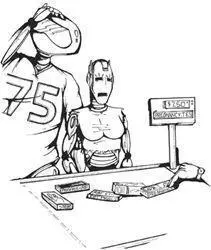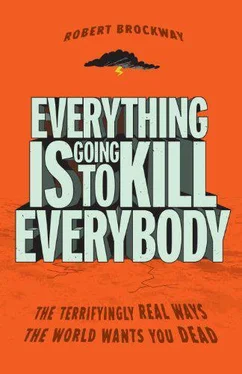We’ve established that it will be inside everybody eventually. Then what? Even supposing that nobody abuses the technology, its very nature makes even the most benevolent intent potentially lethal. Take the respirocytes proposed by nanoexpert Robert Freita: They’re a harmless application, just a kind of artificial red blood cell that pumps oxygen more efficiently and more stably than the natural equivalent—236 times more efficiently, to be precise. Because of this dramatically heightened performance, they would be invaluable in treating disorders such as anemia and asthma, or simply to oxygenate the blood for better endurance and performance in sporting events. In other words, they’re blood-borne nerd fixers.
However, with higher doses of these nanobots, their hosts could also be able to do things like hold their breath for several hours and run at a dead sprint for nearly twenty minutes. And that’s great! How many of you would want to be able to do that? Now, how many of you want anybody else to be able to do that? Go ahead; raise your hand if you want sociopaths who breathe underwater, sprinting rapists, and serial killers who never tire. [2]
Not to mention the worrying fact that these machines are by no means human-specific. The respirocytes take a kind of frat-boy approach to blood: If it’s warm, it needs to be pumped. No further distinctions need to be made. Also of concern is the fact that their durable outer shell and self-sustaining programming make them seriously hardy devices, easily capable of surviving and functioning outside of their intended environment for long durations. And when you factor in how easily they could spread—their transferability by blood and other bodily fluids—you start to get a worrisome picture. One bad accident at the local zoo with somebody hosting these nanobots and next thing you know, you’ve got untiring, superspeed pythons racing through the streets and a terrifying new version of sea lion roaring at the bottom of your pool. In an instant, the food chain is drastically reordered. Though the chief concern for now is just the effect a modified species could have on its local ecosystem, any supercharge in the efficiency of predators is the last thing we need.
After all, humans are only at the top of our food chain because we’re smart enough to compensate for our insane physical incompetence as a species. So… maybe you should start studying. Because pretty soon, a billion tiny robots might be seriously hot-rodding up some grizzly bears, and you? Well, let’s just say you’re going to have to get a hell of a lot smarter in a big hurry if you plan on making it back from the store with both arms.

IF YOU’RE TALKING about nanotechnology at a party, two things are assured:
1. Nobody is going to have sex with you in the foreseeable future, and…
2. Somebody will bring up the Gray Goo Scenario.
The term “Gray Goo,” for those of you probably too busy boning right now to read this, describes the danger of self-replicating nanomachines running amok, forgoing any meaningful objectives in favor of just endlessly reproducing themselves like tiny little robotic Irish Catholics. The term was originally coined by a man named Eric Drexler in 1986, in his book Engines of Creation . He called it this partly because nanotech was just being recognized as the next industrial wave of the future, and also because the far more awesome title, “Engines of Destruction,” was already taken by three Swedish metal bands, two monster trucks, and one particularly shitty mechanic.
In his book, Drexler writes of Gray Goo as something akin to the Midas touch, the simple wish that everything you touch turns to gold, which leads to you dying of starvation, because you cannot eat gold. Here the simple wish is that you didn’t have to build every single goddamned microscopic robot by hand, which leads to your limbs being eaten by robots. Because if you encourage incredibly simple nanobots to build more of themselves, the danger is that they won’t know when to stop pulling apart matter for its raw building materials, then using those appropriated materials to build more robots, which, in turn, will do the same thing. If left unchecked, the nanobots would eventually break down everything into its core elements, effectively restructuring the entire planet into robots. While the idea of an entire planet turning into a robot may indeed make a sweet-ass plot for the next Transformers movie, the unfortunate consequence would be the end of all life as we know it. Not exactly worth the trade-off, in my opinion.
Hindsight Is 20/20
“I guess we shouldn’t have ‘encouraged’ those robots to eat people in order to build more people eating robots.”
—Early nanotech scientist
The terrifying notion of microscopic organisms pulling apart base matter and assembling more dangerous creatures isn’t exactly new. It was originally inspired by DNA, small molecules that break down raw materials and build more complex molecules from them. They gave structure to all life on Earth, and all a self-replicating nanobot does is follow this same concept, with the limiters pulled off. If you did the same thing to human beings, the results would be similar; we’re basically just destructive machines tearing up shit to build more of ourselves until there is nothing left on Earth but a mass of writhing bodies engaged in a gargantuan, planetary-scale accidental orgy.
Luckily Eric Drexler wrote another essay years later that tells us that Gray Goo is just not ever going to happen. He assures us that there is simply no practical need for nanobots to be self-replicating, because it would make far more sense to build tiny “nanofactories” that manufacture completely nonreplicating robots. The factories themselves wouldn’t be autonomous; they’d be immobile and dependent on human resupply, so there would be absolutely no danger of infinite reproduction. Indeed, it would actually be much harder to engineer a single Gray Goo nanobot than it would these simple nanofactories. The factories themselves needn’t be microscopic, after all; they’re actually more likely to be somewhat large in scale—probably around the size of a photocopier. (You may want to keep this fact handy for future reference, lest ten years from now you find yourself at an office Christmas party, drunkenly attempting to photocopy your ass, but instead find that its base matter has been reappropriated into microscopic robots. The normal apocalypse is bad enough. We don’t need one made entirely out of drunken cubicle jockeys’ former butt cheeks.)
Earnest Question
Then why did you invent the entire concept , Eric Drexler?
So it’s easier to build a factory to do the microscale work for you and, of course, there would also be less programming needed for the factory produced nanobots, because unlike the Gray Goo ’bots, they don’t need to procreate, just work. So while that kind of sucks for the little robots (no robot sex for you little guys; there is only work until death), it is pretty good for us; no disintegrating, just magic invisible construction workers! I know that’s a great concept, but do try to avoid saying that phrase out loud until this is common knowledge. It will only generate more odd stares at the person already laughing at a book about the apocalypse. You don’t need the help.
Potential Names for This Rear-End Apocalypse
• Asspocalypse
• Catasstrophe
But all these construction concerns pale in comparison to the fundamentals necessary for a Gray Goo ’bot to even function. Every nanobot would need to have five important capabilities, any one of which, if absent, would render the whole scenario impossible. First of all, to even acquire those building materials (read: your flesh) they would have to be mobile, and that’s a heftier task than you might imagine. Second, power is an issue: How do you power the microscopic nanobot, much less its even smaller nanoengine? It’s not like you pour thimbles of gas into its tiny fuel tank, as adorable as that would be; it needs an entirely new fuel source, and how do you come up with something like that that remains nontoxic to the human body?
Читать дальше













